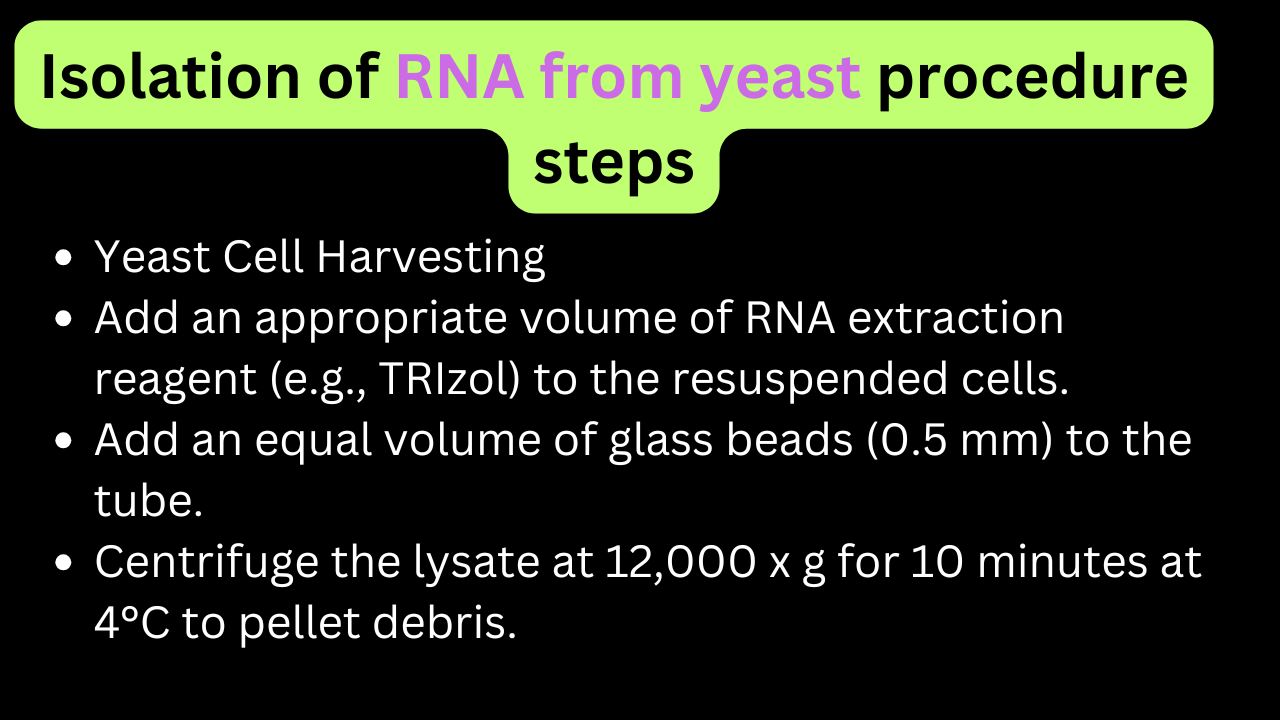The isolation of RNA from yeast involves breaking open the tough yeast cell wall. It also involves ensuring the RNA is protected from degradation by RNases.
Here is the step-by-step procedure of rna isolation from yeast.
Materials Needed for Isolation of rna
- Yeast cells (grown to the desired OD in culture).
- RNA extraction reagent (e.g., TRIzol or similar).
- Phenol:Chloroform:Isoamyl Alcohol (25:24:1 mixture).
- Isopropanol (for RNA precipitation).
- 70% Ethanol (for washing RNA pellet).
- RNase-free water (to dissolve RNA).
- Glass beads (0.5 mm diameter, for cell lysis).
- Bead beater or vortex with bead-beating adapter.
- Microcentrifuge.
- RNase-free tubes.
Isolation of RNA from yeast procedure
Step 1: Yeast Cell Harvesting
- Grow yeast cells to the desired phase (e.g., log phase) and measure OD600.
- Harvest cells by centrifugation at 3,000 x g for 5 minutes.
- Wash the pellet once with RNase-free water to remove residual media.
- Resuspend the pellet in a small volume of RNase-free water or RNA extraction reagent.
Step 2: Cell Lysis
- Add an appropriate volume of RNA extraction reagent (e.g., TRIzol) to the resuspended cells.
- Add an equal volume of glass beads (0.5 mm) to the tube.
- Vortex vigorously using a bead beater or vortex for 5-10 minutes. Alternate between vortexing and resting on ice. This prevents overheating.
- Ensure the cells are completely lysed (the solution will become viscous if RNA is released).
Step 3: Phase Separation
- Centrifuge the lysate at 12,000 x g for 10 minutes at 4°C to pellet debris.
- Transfer the supernatant to a new RNase-free tube.
- Add an equal volume of phenol:chloroform:isoamyl alcohol (25:24:1).
- Mix thoroughly by inverting the tube, then centrifuge at 12,000 x g for 10 minutes at 4°C.
- The RNA will remain in the aqueous (upper) phase.
Step 4: RNA Precipitation
- Carefully transfer the aqueous phase to a new RNase-free tube.
- Add 0.5 volumes of isopropanol to the aqueous phase.
- Mix gently and incubate at -20°C for 30 minutes to precipitate the RNA.
- Centrifuge at 12,000 x g for 10 minutes at 4°C to pellet the RNA.
Step 5: Washing the RNA Pellet
- Wash the RNA pellet with 70% ethanol (made with RNase-free water).
- Centrifuge at 7,500 x g for 5 minutes to remove residual ethanol.
- Carefully discard the ethanol and air-dry the pellet (do not over-dry).
Step 6: RNA Resuspension
- Resuspend the RNA pellet in a small volume (20-50 µL) of RNase-free water.
- Store at -80°C or proceed to downstream applications.
How to check the quality and purity of RNA
- Measure RNA concentration and purity using a spectrophotometer (e.g., NanoDrop).
- Check the A260/A280 ratio (should be ~2.0 for pure RNA).
- Check the A260/A230 ratio (should be >2.0).
- Verify RNA integrity on an agarose gel or using a bioanalyzer.
This procedure ensures high-quality RNA suitable for applications like RT-PCR, RNA-seq, or Northern blotting.
